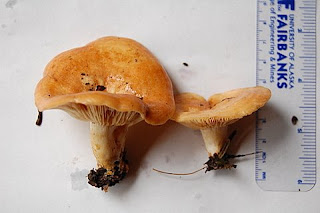Opted to offer the annual mushroom identification class a bit earlier this year with the thought of giving people more time to practice their new skills before the hard frosts ended the season. Besides, it has been a particularly wet and cool summer, so it feels a bit more fall-like. The fungi have been fruiting since July, particularly Entoloma strictius and Stropharia species. Not that fungi fruiting in July is particularly unusual, I've just been in a postion to pay a bit closer attention.
Like every other year, I see both familiar fungi and ones that I've either not seen previously or haven't noticed. Fungi don't fruit every year, at least some fungi don't. Why some species produce mushrooms every year and others don't must be related to something more than nutrition, I'm guessing that temperature is another important factor. It would be interesting to know if it is the same mycelium (genetically) that produces fruiting bodies every year. It would also be interesting to know how extensive the mycelium is from a given species. PCR?
We spent the morning at Starrigavan, mostly on the Mosquito Cove trail and the campground and the early afternoon up Indian river. The fungi weren't as thick or a species rich as they have been in other years, but there was enough. People had the opportunity to collect alot of the Winter Chanterelles, everyone went home with some chanterelles to eat. There were few Hydnums repandums around, but people did get to see them. One student (second time in class) found a nice bunch of Chroogomphus tomentosus to eat as well. Actually, he found quite a variety of fungi. Thinking back, he was an effective gatherer the first time as well. I think he covers alot of ground and has his eyes pretty well trained. His appetite for fungi is an effective motivator.
I didn't keep an exhaustive species list of what we gathered. I did rescue a few Russulas and Lactarius from people in an attempt to continue my quest for some understanding of those 2 genera at least in terms of what occurs around here.

Russula 1: very deep red cap, mild taste, (Medium sized cap), 65mm across, stipe 75 mm tall, wider at base. Spores creamy (almost yellowish). When the cuticle is peeled back the flesh is bright pink at least on the surface. This one keys to Russula cessans in the PNW key council key

Russula 2: deep pink red in center, lighter toward margin, hot taste, (small cap)46 mm across cap, stipe 50 mm tall, stipe evenly wide. Keys to Russula fragilis
 Russula 3: light yellow brown at margin, medium yellow brown at center, striate margin, Viscid, (large)105 mm across, Mild taste, actually kind of tasty. Stipe 70 mm tall, slightly wider at base, a few pink spots (beginning of Indian River trail). Spores cream colored. The young caps don’t smell all that pleasant when broken
Russula 3: light yellow brown at margin, medium yellow brown at center, striate margin, Viscid, (large)105 mm across, Mild taste, actually kind of tasty. Stipe 70 mm tall, slightly wider at base, a few pink spots (beginning of Indian River trail). Spores cream colored. The young caps don’t smell all that pleasant when brokenRussula pectinatoides only problem is that collected specimen is a bit on the large side compared to the description of that species. At beginning of Indian river trail.
http://www.mushroomexpert.com/russula_pectinatoides.html

Lactarius 1: Medium Orange-yellow and light Orange yellow. Concentric rings, white latex, hot taste, 65mm across cap, 35 mm stipe.
Lactarius olympianus
http://www.mushroomexpert.com/lactarius_olympianus.html
http://www.svims.ca/council/illust/Lactarius%20olympianus%201%20Michael%20Beug.htm
Lactarius 2: pale to light Orange yellow. Hot, white latex, cap 40mm across, stipe 25 mm. (spotty looking). The specimen I colllected was immature. Probably L. alni
 cola. Alas no photo
cola. Alas no photoTremella foliacea
I hadn't seen this leafy brown jelly fungus previously. It was growing on a dead hemlock
Pseudohydnum gelatinosum (a very tiny individual)
Nidula candida
Hydnellum aurantiacum
Hydnellum suaveolens
Hydnum repandum

Hydnum umbilicatum
Sarcodon calvatus (in a cluster at the base of a tree near the picnic shelter). Brown spored. In photo at right
Also collected:
Entoloma strictius
Clitopilus prunulus
Collybia acervata
Chaliporus piperatus (two found)
Mycena aurantiidisca (the minute orange ones)
Laccaria laccata
Craterellus tubaeformis

Cortinarius spp
one with substantial bulb, viscid cap, top of stem purplish, lower stem rusty with veil remnants. Gills purplish. Too far gone, actually it was rather mushy
Inocybe spp (didn't bother with these)
Tricholoma vaccinum (best fit) Cap is dry, with orange/red brown fibrils over a yellow/brown base cap. In young caps the fibers are densest at center then further apart at edges. In older caps the center also has the densest fibrils, which are radially arranged toward the margin. (no photo)
http://www.grzyby.pl/gatunki/Tricholoma_vaccinum.htm
A small truffle; Alpova trappei (yellowish smooth outer surface) Looked like small, very small potatoes

Ramaria testaceoflava (green stain in ferric sulfate)
Thanks to Ron Exeter's gift of his book "Ramaria of The Northwestern United States"
Omphalina (Lichenomphalia) umbellifera
Blue Mycena ( seems like amicta)
Amanita pantherina (one)
Chroogomphus tomentosus
Indian River
Mycena haematopus (nicely bleeding, growing on wood)
Amanita vaginata
Russula 3(see above)
Lactarius spp
Craterellus neotubaformis
Collybia acervata (lots) Gymnopus acervatus in Orson & Hope Miller's North American Mushrooms
Clavaria purpurea (by river, dipper gravel bar)
Pleurocybella porrigens ( just a few, older ones)

No comments:
Post a Comment